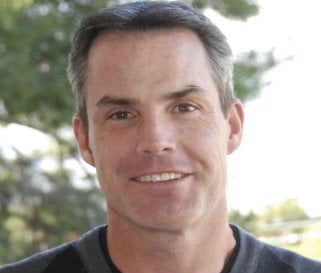“Dad, you HAVE to see this place,” my 11-year-old daughter insisted upon returning from an open house viewing with our neighbor - something they (her and her sister) do for fun on Sundays. The house was HUGE, even by LA celebrity standards. And, it had just been remodeled. My kids’ eyes bulged bigger as they moved from room to room imagining the world of "Bennifer"and "Brangelina." (They may also have been thinking, “Our parents are deadbeats.”)
Dreamkiller Dad
The house was breathtaking! So much space seemed perfect for a family ... wanting to spend time apart. The kids, though, saw it as the land of unicorns and rainbows. You know, heaven!
I certainly didn’t want to be Dreamkiller Dad.
I thought it might be a good idea (hopefully not in a George Costanza sort of way) to help reframe their castle-in-the-sky plans. With the world’s screaming that money, stuff, and status are "the bomb,” my wife and I want our kids to focus on what's most meaningful ...
So I showed them Graham Hill’s “Less stuff, more happiness” TED Talk.
Did you watch the video? It’s only 6 minutes!
Hill succinctly describes an alternate universe of reasonably sized domiciles designed to accommodate one’s needs and reasonable wants.
He begins and ends his talk atop a box of stuff.
We never learn what’s in the box.
It doesn’t matter.
Stuff doesn’t matter.
Hill points out that the amount of "stuff" we own has grown beyond the space we have available. Perhaps that's why we are the "McMansion" generation, living in homes 3X the size of those we lived in 50 years ago. At the same time, the storage space industry is $22 billion and growing. Yikes!
As Dan Gilbert details in Stumbling on Happiness, we are attracted to new things because they are new.
“When we start shopping for a new pair of sunglasses, we naturally contrast the hip, stylish ones in the store with the old, outdated ones that are sitting on our noses. So we buy the new ones and stick the old ones in a drawer. But after just a few days of wearing our new sunglasses we stop comparing them with the old pair, and—well, what do you know? The delight that the comparison produced evaporates.”
We’ve all been there. Our kids have been there. We are terrible predictors of what will make us happy, and Gilbert’s message is one to keep in mind continually. Stuff, new or used, does not make one happy or fulfilled.
Stuff doesn't matter. This is the lesson we must impart to our kids (and ourselves).
Tiny Obsessions
My wife is pretty good about humoring my obsessions, but my mini fascination with tiny houses concerned her a bit. We are very fortunate that we have choices, and I reassured her I wasn't looking to move us into a container. In fact, as she points out in her blog about tiny houses, now that our kids are old enough, I like to book separate rooms for them on vacations. I get the need for some personal space. I did, however, want to get the message through to our kids that bigger and more are not better.
It’s important to talk about money with your kids earlier than you might think. You want to impart your values, not those of advertisers, because no matter how much you shield your children from media, they are being actively taught to consume.
What to do? Set up an allowance.
Financial education for kids begins with an allowance - at any age. An allowance is the single best tool to help kids begin to gain perspective on money. When they have their own money, it changes the conversation you have with them. For example, my daughter just told me that she wants to be a unicorn for Halloween (Who doesn’t?), and she asked if she - or her mom and I - would be paying for the costume.
Whether or not we decide to pay for the costume or go halfsies with her, the point is that she ASKED the question. ANY kid can have this frame of mind when given responsibility over her own money.
Keep It Simple
It isn’t magic. You don’t set up an allowance and hope your kids will absorb your monetary wisdom. Modeling frugality is important for them to observe. If you’re telling them to think through their money choices while you’re building up a collection of Electric Neon Ponies … well, you get the point.
Hands-on experience kids receive with an allowance is essential … as are the discussions around decisions they don't see, like our recent iPhone vs Prius exchange.
My daughter was rightfully puzzled when I told her an iPhone wasn’t in the budget after we’d recently purchased a new car. To her, the relative cost of the phone was tiny. We explained that the car was needed for transport, and we decided on a Prius that would save gas money and was less expensive than other options we considered. She didn’t walk away thinking that her dad was the second coming of Stephen Hawking, but at least she understood there was some thought behind our “dreadful” decisions.
Explain. Explain. Explain again.
Even if your kids seem too young for the money conversation, explain that you’re starting a program so they learn how to use money as a tool. Point out the core concepts they’ll be learning: distinguishing between needs and wants, saving for goals and making smart money choices. Explain that they’ll probably make mistakes, and that’s perfectly ok. They don’t have to get it at first. It will likely take some time.
And, if you go too far?
When we first started teaching our kids about money smarts, we implemented a plan: For every gift they received, they’d have to give away something. (The battle against STUFF begins early!) My then 4-year-old didn’t fully get it because we didn’t fully explain it. On the way to Goodwill, which we called “charity,” she glared at me in the mirror. “I want to play with Charity. She has all my toys.”
You, like them, will learn from your mistakes. These FAQs might help. Reflect on the gaffes, and adjust. If necessary, explain to your kids that you made a mistake, and use it as an opportunity to model an important behavior.
Maybe the next time my daughter says, “Dad, you HAVE to see this place,” we’ll end up here.







